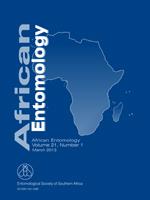Lacewings (Chrysopidae) are important beneficial insects in nearly all cropping systems. However, monitoring of lacewing numbers is difficult due to the nocturnal behaviour of adults and the difficulty of finding eggs and larvae on plants. Techniques facilitating easy finding of eggs and adults will result in improved pest management decisions and monitoring of these beneficial organisms. This study was conducted to determine flight activity patterns as well as preferred oviposition sites of lacewings on maize plants to facilitate time-effective searching for eggs. The daily flight activity pattern and flight height of lacewings were recorded and sweep-net samples were taken to determine lacewing numbers in different adjacent vegetation types (maize, lucerne, natural veld). The preferred area of oviposition was determined by inspecting maize plants for lacewing eggs and recording the distribution of eggs on leaves. Chrysoperla pudica (Navás) was the predominant species in maize. Lacewings were most active between 16:00 and 22:00 and flew largely between 0.5 and 2.5 m above ground level. Oviposition occurred predominantly on leaves near maize ears. Data on spatial distribution of eggs facilitate monitoring of eggs numbers in maize cropping systems and is also of use in general pest management.
BioOne.org will be down briefly for maintenance on 17 December 2024 between 18:00-22:00 Pacific Time US. We apologize for any inconvenience.
How to translate text using browser tools
1 March 2013
Patterns of Lacewing (Neuroptera: Chrysopidae) Flight Activity, Flight Height and Spatial Distribution of Eggs on Maize Plants
R. Keulder,
J. Van den Berg
ACCESS THE FULL ARTICLE
It is not available for individual sale.
This article is only available to subscribers.
It is not available for individual sale.
It is not available for individual sale.

African Entomology
Vol. 21 • No. 1
March 2013
Vol. 21 • No. 1
March 2013
beneficial insects
Chrysoperla spp.
egg scouting
monitoring
non-target insects




